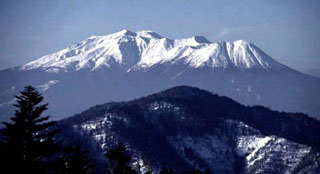Report on Ontakesan (Japan) — 15 January-21 January 2025
Smithsonian Institution / US Geological Survey
Weekly Volcanic Activity Report, 15 January-21 January 2025
Managing Editor: Sally Sennert.
Please cite this report as:
Global Volcanism Program, 2025. Report on Ontakesan (Japan) (Sennert, S, ed.). Weekly Volcanic Activity Report, 15 January-21 January 2025. Smithsonian Institution and US Geological Survey.
Ontakesan
Japan
35.893°N, 137.48°E; summit elev. 3067 m
All times are local (unless otherwise noted)
The Japan Meteorological Agency (JMA) reported increased seismic unrest at Ontakesan. The number of small volcanic earthquakes with epicenters near the summit had increased in mid-December 2024 and further increased in January 2025, most notably on 16 January. Volcanic earthquake totals of 5-8 per day were recorded during 10, 12-13, and 15 January. There were 24 and 19 volcanic earthquakes recorded on 11 and 14 January, respectively. Seismicity escalated on 16 January, with 27 volcanic earthquakes. The Alert Level was raised to 2 (on a scale of 1-5) at 2200 on 16 January and the public was warned to stay 1 km away from Jigokudani Crater. Deformation data did not show any ground movement.
A total of 8-13 daily volcanic earthquake were recorded during 17-20 January. On 21 January the deformation network recorded summit inflation and the number of volcanic earthquakes significantly increased to 273 by 1900. Fumarolic activity remained at normal levels; white emissions from Jigokudani Crater rose 200 m.
Geological Summary. The massive Ontakesan stratovolcano, the second highest volcano in Japan, lies at the southern end of the Northern Japan Alps. Ascending this volcano is one of the major objects of religious pilgrimage in central Japan. It is constructed within a largely buried 4 x 5 km caldera and occupies the southern end of the Norikura volcanic zone, which extends northward to Yakedake volcano. The older volcanic complex consisted of at least four major stratovolcanoes constructed from about 680,000 to about 420,000 years ago, after which Ontakesan was inactive for more than 300,000 years. The broad, elongated summit of the younger edifice is cut by a series of small explosion craters along a NNE-trending line. Several phreatic eruptions post-date the roughly 7300-year-old Akahoya tephra from Kikai caldera. The first historical eruption took place in 1979 from fissures near the summit. A non-eruptive landslide in 1984 produced a debris avalanche and lahar that swept down valleys south and east of the volcano. Very minor phreatic activity caused a dusting of ash near the summit in 1991 and 2007. A significant phreatic explosion in September 2014, when a large number of hikers were at or near the summit, resulted in many fatalities.

